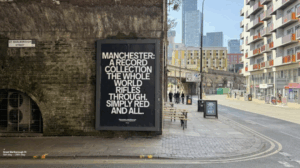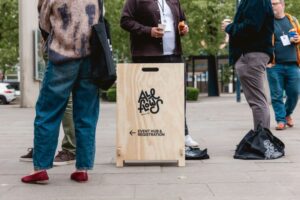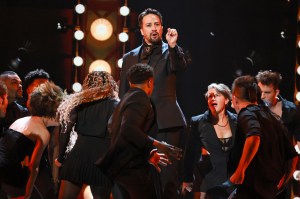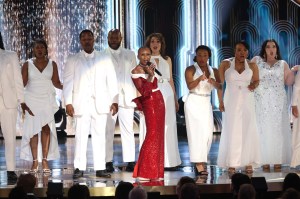For the Wing Luke Museum, Storytelling Is a Path to Healing


America’s Cultural Treasures: This article is part of a series sponsored by the Ford Foundation highlighting the work of museums and organizations that have made a significant impact on the cultural landscape of the United States.
We tell their stories, because if we don’t, no one else will — at least within the museum field.
Jessica Rubenacker, director of Exhibitions, Wing Luke Museum
Let’s start with a story.
“Growing up as a person of color in the United States, you don’t see yourself represented in media or whatever out there in positive ways,” recalls Doan Diane Hoang Dy. “So, I actually grew up not liking my heritage, my name. ‘Why can’t I have a name like Sarah Johnson or look like the other kids at school?’ kind of thing.”
Everything changed when she took a class called Contemporary Problems for Asian Americans as an undergraduate at the University of Washington. “That was where I was able to learn why I was feeling all of that self-hate, and able to really undo it,” she explains. “My professor, Connie So, she was my mentor, and [it was] really amazing to see somebody who looked like me talking about this stuff and helping to unlearn and to educate folks, and then the light bulb went off. I was like, ‘I want to do that.’”
Then, Dy got the opportunity to volunteer at the Wing Luke Museum in Seattle for school credit. In addition to transcribing oral histories, she helped select meaningful quotes to include in the museum’s exhibitions. Crucially, she says, the work allowed her to see the connections between the interviewees’ experiences and her own, “an amazing embodiment of all these things I felt [were] really powerful and important.”
“So, I knew that I wanted to be here.”
Having begun her tenure in 2012 as a part-time education guide, Dy is now the associate tour director at the Wing Luke Museum. She is the daughter of Vietnamese refugees who arrived in the United States in the 1980s, and she grew up in Burien, a suburb south of Seattle located on Puget Sound. In her capacity as associate tour director, she has led tours and managed 10 education guides since 2015. Through her work at the Wing Luke Museum, she narrates and facilitates the production of many personal and historical accounts the institution imparts to its visitors and patrons. Several meanings can be drawn from her journey, but in its essence, it is about being wounded or afflicted and finding her way to health.

The affliction is personal, an individual introjection of a sense of being “other,” odd, different, unwelcome, undesirable. But following Dy’s telling, the curative is communal: to be shown through the eyes and voices of others with similar experiences that an entire set of kindred people have often been wounded in this way and have collectively developed reparative practices. Joël Barraquiel Tan, former executive director of the Wing Luke Museum, identifies nurturing the well-being of the museum’s community as the core part of the staff’s work. The museum’s stated mission to “connect everyone to the dynamic history, cultures and art of Asian Americans, Native Hawaiians, and Pacific Islanders through vivid storytelling” took on a public health aspect under his leadership. “We see everything through that lens of wellness and then we basically employ the tactics that we’ve cultivated in art and culture,” he says.
Before taking on his role at the Wing Luke in April of 2022, Barraquiel Tan had served as director of community engagement at San Francisco’s Yerba Buena Center for the Arts, where he created civic engagement initiatives that looked to empower community members to tell their own stories and have a hand in creating exhibitions and programs. Barraquiel Tan moved to Hawaii in 2015 to serve as executive leader at a few institutions: the East Hawaiʻi Cultural Center, the Kalani Honua Retreat Center, and Touching the Earth Farm, a regenerative tropical fruit tree farm that focuses on building healthy soil and communities. His experience in these posts has led him to understand that “culturally rooted work that sometimes appears as art, sometimes appears as ceremony or ritual, consistently creates better health, creates better government and better economy.”
To ply this culturally rooted work, Barraquiel Tan recognized that interior labor needed to be done to promote and develop wellness practices as a foundation for the museum. “The work of wellness has to start within the house, meaning the only way you can promote wellness is based on the conditions of your own wellness,” he says. “The idea is that we have to create a certain level of wellness so that we can perpetuate our mission’s work into the future.”
This is a somewhat unorthodox mindset for US arts and culture organizations. Operating from a place of bare survival is typical for these institutions given the country’s general neoliberal disposition that regards the market as the proper first and final arbiter of whatever is culturally produced, which outside of financial profit isn’t seen as crucial to civic life. This attitude is combined with what had previously been the federal government’s attitude of miserly neglect of the arts, and has now turned to active disdain for programs that cultivate heterogeneous audiences and address issues of inequity. Moreover, there is an enormously wealthy though fickle philanthropic class that conspicuously takes on the burden of support when it suits them.
Thus, smaller organizations often perform under conditions of financial and infrastructural precarity, with overworked and underpaid staff, often unsure whether they will endure through the next fiscal cycle. Steve McLean, senior director of Strategic Communications, who came to the museum with a background in community healthcare, recognizes this while observing that Barraquiel Tan purposefully charted a different course for the Wing Luke.
“Joël wanted to take the organization in an evolved direction. Like many smaller, cultural museums like ours, there’s a prevailing austerity mindset, because institutions like ours have had to operate that way,” says McLean. “Everything is about just maintaining and staying put, but Joël really had a big vision to stabilize the organization and set it up for future success.”

Buoyed by multi-million dollar grants from the Ford Foundation and MacKenzie Scott (which buck philanthropic trends by providing unrestricted funding), Barraquiel Tan increased staff salaries to ensure people could live in King County; oversaw the implementation of a wellness index; and, based on a model propagated by the National Institute of Health identifying eight dimensions of wellness, revised office policies, all within his first year as executive director. According to Barraquiel Tan, “We’re building better conditions so that the wellness starts here, so that we have better boundaries around how we work, how much we work, when we work, so that we’re not always dealing with lack.”
Barraquiel Tan was the first queer, immigrant, and Filipino person to lead the museum. However, just as key is his innovative approach to the museum’s core philosophy: the idea of “art and culture as apothecary.” The evolution of a wellness-focused approach to the overall mission of the museum comes out of the experience of Dy and others who have found healing through community members telling their stories. As noted in the museum’s 2023 Annual Report, “Well-Being, Healing, Rebuilding,” for Dy, “the preservation of culture, keeping people grounded, and telling those stories is the healing; it is the well-being.”
However, the Wing Luke Museum was not always this oriented toward wellness and storytelling.
The museum was founded in 1967 as a completely volunteer-led organization. It was created to commemorate the life of Wing Chong Luke, the late Chinese-American lawyer elected to the Seattle City Council and the first Asian American elected to public office in King County. Luke immigrated from China at the age of five around 1930, grew up in Seattle, served in the US Army with distinction (earning the Bronze Star medal), and in 1957 became the assistant attorney general of the State of Washington, in the Civil Rights Division. Luke held the position until 1962 when he ran for and won a seat on the Seattle City Council, where he sought to remake public policy concerning urban renewal, historical preservation, and civil rights.
During his first year in office, he crafted an open-housing ordinance to prevent discrimination in the sale or rent of Seattle real estate. It initially faced considerable resistance but was eventually passed into law. In 1965, he died in a plane crash on Merchant Peak in the Cascade Mountains. Several colleagues and friends created the Wing Luke Memorial Foundation in honor of his life’s work and dedication to civil rights. Some of the money they’d initially raised to search for him was later used to found the Wing Luke Museum in the Chinatown-International District (C-ID), a combination of Japantown, Chinatown, Manilatown, and Little Saigon, and the only pan-Asian neighborhood of its kind in the country. Since 2008, the Wing Luke Museum has been housed in the East Kong Yick Building, a four-story hotel erected in 1910 by an association of about 170 Chinese-American community members who wanted to create a structure that would anchor a renewed Chinatown.
Julie Salathe, the museum’s director of Grants and Scholarships, offers that Luke was “an advocate for [the] preservation of arts and culture,” which she regards as part of a larger social justice project: making the lives of Asian Americans, Native Hawaiians, and Pacific Islanders (AANHPI) visible and meaningful to themselves and other residents of Seattle. The museum, which is the only pan-Asian art and history museum in the country, began its existence as a storefront that featured folk art and crafts. For approximately the next 24 years, it would focus on this type of material culture.

In 1991, the institution hired Ron Chew as executive director. He became the museum’s first Asian-born director and took the Wing Luke in a different direction. According to the Community-Based Exhibition Model publication (known as the Blue Book) written by former Deputy Director Cassie Chinn, who explains and documents the museum’s unconventional and innovative method of developing exhibitions, Chew’s leadership ushered in an era of “plac[ing] the stories of the Asian Pacific American community at the forefront of its mission.”
“At that time, we were a small institution with few resources. We did not have much experience building exhibitions, but we knew the people intimately tied to the history, having lived it ourselves or having grown up hearing the stories from our parents and grandparents,” Chinn writes. “We identified the community as our core constituency and number one asset.”
One of the first exhibitions generated under Chew’s direction was Executive Order 9066: 50 Years Before and 50 Years After, shown in the museum’s main gallery in 1992. The exhibition chronicled the tale of Japanese-American citizens and legal residents who were forcibly evicted from their homes and incarcerated in concentration camps during World War II. Three coordinators, Harry Fujita, Michelle Kumata, and Sally Yamasaki, convened a community advisory committee (CAC) of about 30 people from the Japanese-American community. This group met for about a year and contributed their personal and familial keepsakes to the exhibition. Jessica Rubenacker, the former director of exhibitions, spent a little over 10 years with the Wing Luke. She says that because of the success of Executive Order 9066, the CAC process continued to be used for all the exhibitions that came after.

“From what I hear, it really put the museum on the map in a new way,” she says. “People lined the block to come in and see this exhibit because it was the first time that the Japanese-American community really told their story on their own terms.”
Cassie Chinn, who stepped down from her position as deputy director in the summer of 2024, started her tenure as a volunteer college intern in the Collections department in 1992. She explains that in 1994, when she began working with Chew on organizing community-led exhibitions, she adapted this new model to an older, inherited one.
“Ron Chew was the director at that time and was espousing this premise about creating exhibitions hand in hand with community members. So, I took that as my charge to figure out how you do that on an ongoing basis,” she says. “I was like, okay, let’s look at what the classic method might be for creating exhibitions in museums, and let’s just figure out as many touchpoints as we could to integrate community members into that.”
Again, Chinn via the Blue Book lays out the philosophical underpinnings of the CAC model, details its process, and lists the exhibitions created according to this design. Chinn writes what she understands to be the rationale of the CAC framework: People from the community are involved in every major step of making an exhibition. “Our community-based exhibition model aims to integrate community members throughout the process, from exhibition development to design to fabrication and installation, and including exhibition fundraising, publicity and marketing, education and public programming,” Chinn writes, elaborating that museum staff in this process are essentially “technical advisors.”
The core CAC typically includes 10 to 15 individuals who serve as the primary decision-makers who “develop the main messages, themes, content and form of the exhibition and its related components.”
Chinn also breaks down the separate components of the process; for example, when selecting CAC members, she advises: “Include not only professional scholars and artists, but also everyday folk with lived experiences. Maintain an environment with everyone learning from one another.” The primary questions that each CAC seeks to answer are: What should visitors who come to the exhibition learn or experience? What are the major areas, subjects, or themes within the community that are being explored?
In 1993, the Wing Luke installed the permanent exhibition One Song, Many Voices: The Asian Pacific American Experience, which looked at many of the ethnic groups within the AANHPI family through the lens of immigration, employment, discrimination, and cultural habits. The installation has evolved over the years and is now titled Honoring Our Journey, speaking to the breadth and variety of experiences that is at times unhelpfully shorthanded to “Asian.”
Earlier exhibitions also give a sense of the myriad issues and questions the museum parses on behalf of its communities. Among them are Twenty Years After the Fall of Saigon: The Vietnamese American Story (1995); Out of Focus: Media Stereotypes of Asian Pacific Americans (1996); From Awareness to Healing: Asian Pacific Americans and AIDS (2001); It’s Like That: Asian Pacific Americans and the Seattle Hip-Hop Scene (2003); and Women and Violence (2005). All of these exhibitions make it clear that the stories being told by individuals and groups are histories. They just have not been canonized, and thus are not yet as brightly lit.

During this writing, an exhibition titled Confronting Hate Together — which was designed to be a collaborative partnership between the museum, the Washington State Jewish Historical Society, and the Black Heritage Society of Washington State, all communities that were redlined together in Seattle — opened in May of 2024. Its debut exposed some of the fissures between the various communities the museum has long sought to bring together. The challenges presented by the controversies surrounding the exhibition, coupled with the widening impact of global events at the time, resulted in Barraquiel Tan stepping down as executive director. This situation demonstrates what is at stake in institutions telling stories: Some stories demand very careful handling and, even when conveyed with care, carry a cost for the tellers and the listeners because pain is a natural and necessary part of the diagnostic and healing process.
For members of the C-ID communities, there is a palpable need for these new histories, because some are wounded in their absence. Jessica Rubenacker grew up a mixed-raced Filipina American in Bloomington, Illinois, feeling that absence.
“There was a lot of internalized racism I had to overcome. I didn’t learn about the Japanese-American incarceration until I took an Asian American Studies course my senior year of college, and I just, I couldn’t believe that,” she contends. “I couldn’t, that my Illinois public school education had failed me.”
For Chinn, the failure of the primary and secondary school systems to incorporate the accounts of Asian Pacific Americans in telling the American story is purposeful: “Our time in the US has always been in the context of exclusion and erasure. Those systems are set up so your stories are not recorded, not passed on from generation to generation,” she explains.
“That’s where you end up with this sense of dislocation, purposefully. You’re the forever foreigner. In the school system, you’re not getting anything, maybe a little bit: Chinese built the railroads, World War II, one paragraph. Nobody makes it up to the US-Vietnam War in US history classes. Across the board, it’s been to exclude, to erase,” Chinn continues. “So, where are those places that the stories can be told, recorded, preserved, and then told again and again for the next generations?”
Han Eckelberg, who is half Chinese and half German, an artist, a martial arts instructor, and a part-time education guide for the museum, makes the case that the Wing Luke is one such place for exchange and preservation. He observes meaningful changes in people he takes on tours around the neighborhood. “People come to us to learn more about themselves, their own identity, which I think is the most fulfilling because you can see something that resonates with them,” he reflects. “They light up, and they ask more questions, and they find more of themselves.”
These tours of C-ID given by staff are an indispensable tool for the museum to carry out its mission. The museum’s own historic hotel and neighborhood walking tours include a Redlining Tour, tours of the Immigration and Naturalization Services building, a Japanese American Remembrance tour, a Hometown Chinatown tour, and various food walks. The food tours in particular serve a double purpose, McLean explains.


“Food tours [are] not only designed to introduce culture to people — food is culture — but it actually helps draw business to those restaurants,” he says. “Many of them are multi-generation. Many of them are small, mom-and-pop-type operations. We’re doing our part to bring some economic vitality here.”
Among some art and culture nonprofits, the idea of aiming for commercial success is distasteful. Capitalism is viewed as a necessary evil that poisons most of what it touches. However, Barraquiel Tan’s idea of art and culture as apothecary encompasses spiritual, social, environmental, and economic wellness. Art and commerce need not be viewed as diametrically opposed. Moreover, by making the history of the C-ID available to visitors through the aesthetics and pleasures of food, more people are welcomed to the museum’s mission.
Kamahanahokulani Farrar, like McLean, came to the museum with a background in public health. She was working as the senior director of Finance and Operations at the museum but is now the interim executive director. She looks to welcome everyone within the sound of the museum’s voice to partake of the art they are offering. “In public health, years ago, it was really common that you could get a prescription from your doctor to get organic food from your local farmer’s market,” she says. “What we’re saying, from a public health perspective, or a human perspective, is art belongs to all of us.”
Somewhat paradoxically, while Dy’s story begins in the very specific terms of her own shame and sense of illegitimacy, her experience is emblematic of a collective immigrant experience. All immigrants to this country have had to contend with questions regarding the relationship between themselves and the new land they have settled in. Many wrestle with all the ramifications of feeling displaced, ignorant of the new culture and what their place in it might be.
For Dy, finding support among the people who resemble her (and finding connections with people who do not) is a unifying realization, and one that moves within and beyond the borders of the AANHPI communities.
“Our museum amplifies how these stories are uniquely American. I want my staff to advocate and work towards giving our guests a bigger picture of the intersections of our realities,” Dy says. “It might be more about Asian American, Native Hawaiian, Pacific Islander stories, but when we can understand how [they] intersect with the African-American, Coast Salish Indigenous community in Seattle — where those lines blur because we had to share this discrimination together — that’s where we can see the bigger picture of how we’re all in it together.”
That “it” is a complex, multiethnic society with a checkered past full of racial violence and mercenary brutality, alongside idealistic rhetoric about the value of human equality and profound social movements that moved the nation practically closer to meeting these ideals. It is a country of enormous economic disparities, that despite its palpable contradictions, still draws immigrants who cross formidable physical and political barriers and risk immiseration and even death, to get here. And once they arrive, how will their lives inflect the larger American narrative? The Wing Luke Museum tells us that to answer this question, you must first ask to hear their own stories.
This article is licensed under a Creative Commons Attribution 4.0 International license.







